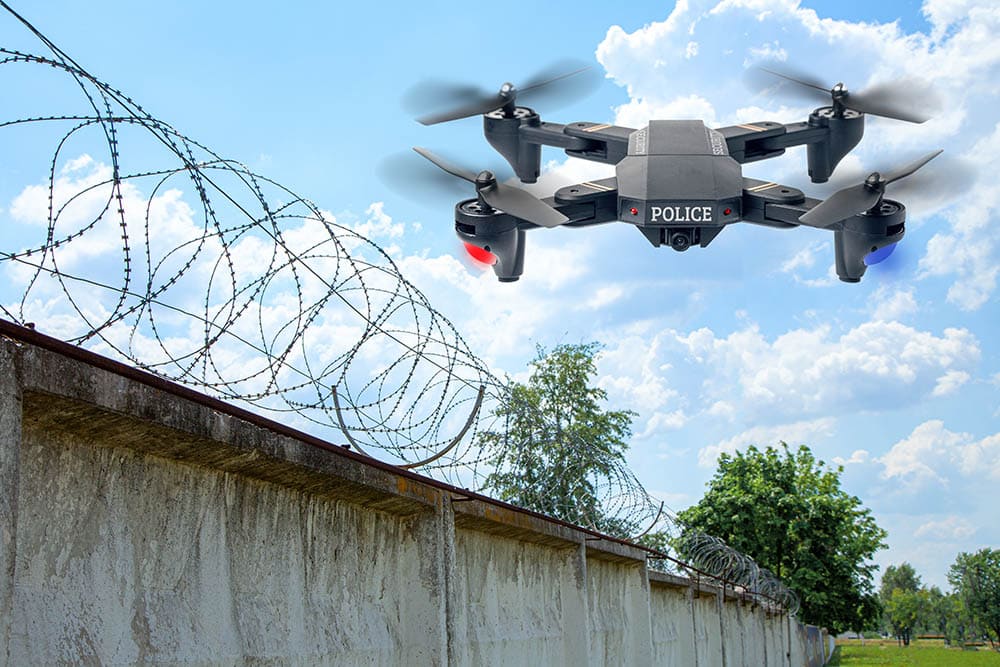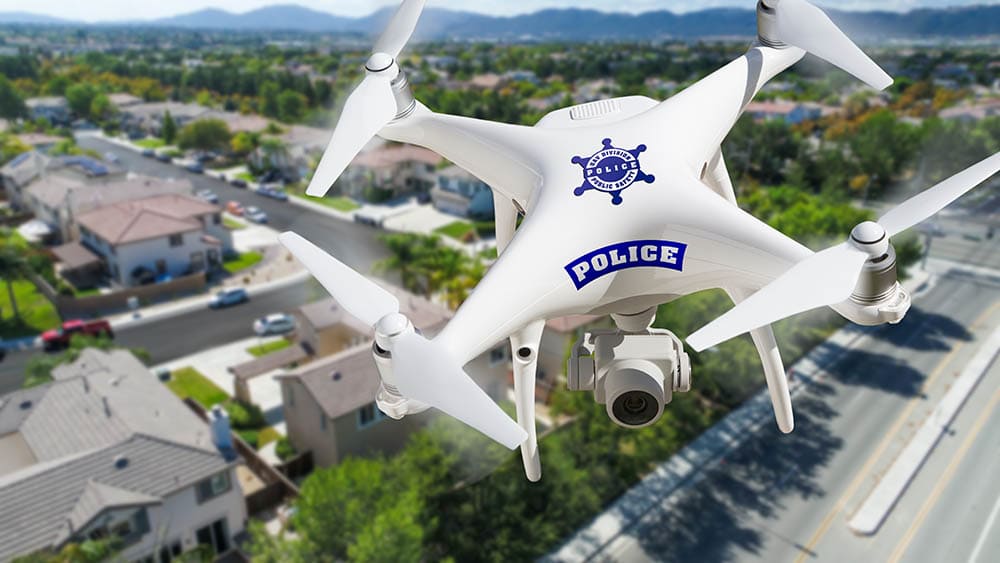9 Interesting Police Drone Facts You Never Knew!
Last Updated on

Drone technology within the police force is proving to be profoundly beneficial. Drones have been pivotal in collecting data, finding missing persons, and investigating crimes more efficiently and safely. Also known as UAVs (Unmanned Surveillance Vehicles), they provide real-time information, proving to be one of the most useful tools in the police force.
The devices have revolutionized the work of law enforcement and are still proving to be highly successful. They may provoke fears of privacy, but the use of drones within the police force can essentially save lives. We gathered interesting facts about police drones to help you understand how remarkable this technology has become and how it has enhanced law enforcement.

The 9 Interesting Police Drone Facts
1. Police Drones Can Be Used to Find Missing People
Police Drones are used to find missing people using thermal imaging sensors that detect heat and cameras that give police a bird’s-eye perspective. This technology is instrumental in finding missing kids who have wandered from their homes or lost backpackers deep in the mountains. The recognition software is compact enough to run on a phone, and the technology is still advancing and learning as it goes.
2. Police Drones Are Great for Gathering Evidence
Drones can assist in collecting evidence that is hard to reach from the ground. They can survey a crime scene within minutes and provide 3D images and maps. They can also fit into smaller areas that helicopters can’t and cover large sites, quickly and efficiently gathering evidence to assist with investigations. Drones can provide lighting in low-lit areas and obtain otherwise hard-to-collect evidence in minutes.
3. Police Drones are Used for Fast Disaster Response
Drones can travel at high speeds and be deployed immediately, covering large areas more efficiently and in a shorter time than traditional ground teams. They can also be deployed faster than police helicopters.
Drones play an important role in examining the aftermath of disasters. Police can evaluate and familiarize themselves with the environment and situation before arriving on the scene, making them better prepared. Drones assist in making the work for the police service quicker and safer and are vital to saving lives.

4. Drones Can Vary in Size and Ability
From wingspans of up to 66 feet to crafts disguised as hummingbirds, the police force can effectively watch from the air with the variation of size and ability of UAVs. Customs and border patrol rely on larger drones that can stay in the air for up to 30 hours and reach an altitude of up to 50,000 feet.
Then there is a drone with a wingspan of 6.5 inches, weighing lighter than an AA battery and disguised as a hummingbird. It is equipped with a tiny camera for surveillance and can stay in flight for 11 minutes. Some have features that sense and avoid to help prevent collisions, operate in high temperatures, withstand high wind speeds, and have high-security features.
5. Police Can Equip Drones With Advanced Surveillance Tools
Police can equip their drones with infrared or heat-sensing cameras and live video. Some cameras can zoom in from miles away and focus on faces or license plates; others can scan and record large neighborhoods. Some drones are equipped with WiFi sensors that can track wireless devices capable of delivering spyware.
In North Dakota, a 2015 law makes it legal for police to use aerial drones for surveillance and equip drones with nondeadly weapons such as tasers.
6. Police Drones Can Reconstruct Traffic Collisions
With the ability to capture aerial images and 3D mapping, police can reconstruct traffic collisions. The usual approach to mapping out accident scenes is manually identifying skid marks and other important parts of the scene with measuring tape, which can take hours.
Drones can collect a sufficient amount of data more accurately and in a shorter time to map out an accident scene for investigation. They can quickly identify injured people and get them medical attention while determining if the scene is safe to approach. By speeding up data collection, drones are helping reduce the chances of a secondary collision.

7. Drones Can Talk to One Another
Drone swarms can coordinate operations with little to no operator intervention. They can cooperate and work together to perform various tasks that a single drone cannot.
They can avoid collision and maintain separation with real-time sensing, artificial intelligence, and computer vision algorithms. Their communication relies on satellite and radio frequencies. A drone swarm can survey a city in greater detail than a few helicopters.
8. Police Drones Can Identify You
Live surveillance video allows police to scan pedestrians’ faces continuously. With a drone’s ability to zoom in precisely and capacity for aerial surveillance, individuals and their activities can be identified and cataloged with little effort.
Automated license plate readers and facial recognition technology make it easy to identify and track individuals from far distances.
9. Police Drone surveillance Is cheaper
Millions of dollars are spent on helicopters and pilots, as well as operating and maintenance costs. It is easier and more cost-effective to train law enforcement officers to operate drones than to fly helicopters.

Police Drone Statistics
- For a police department to kickstart a drone program with two drone systems, it will cost, on average, $35,000–$55,000.
- In 2021, the NYPD conducted 75 drone operations across the five boroughs.
- Florida’s Polk County Sheriff’s Office flew more than 750 missions which assisted in arresting 31 suspects and locating five missing persons within the first 18 months of operating their drone program.
- The global law enforcement drone market is anticipated to grow from 500 million dollars in 2020 to 2.8 billion dollars by 2030.
- 93 law enforcement agencies from across the country deployed drones 1,171 times in 2020, costing almost one million dollars.

What Kind of Drones Are Used in Law Enforcement?
The best drone technology for the police force requires high-quality real-time video, high-security features, and user-friendly operation. These are some of the drones typically favored by the police force:
- DJI Inspire 2
- DJI 300 RTK
- DJI M210
- DJI Mavic 2 Enterprise
- V Mark II
- Skydio
- Condor
- X8 Long Range Surveillance Drone
- Impossible Aerospace US-1
Police Drones and Privacy
The use of police drones has evoked privacy concerns, and state legislature continue to debate if and how drone technology should be regulated. Since 2013, 44 states have enacted laws, while three have adopted resolutions.
Currently, police are not allowed to fly drones over neighborhoods and look through windows without a warrant.

Final Thoughts
The use of drone technology radically improves public security, as well as the lives of our police force. They significantly enhance the work of police services by improving efficiency, surveillance, and crime-fighting.
Emergency services across the world could benefit from implementing drone technology. They are undoubtedly a positive step in law enforcement.
Featured Image Credit: ADragan, Shutterstock
Table of Contents
- The 9 Interesting Police Drone Facts
- 1. Police Drones Can Be Used to Find Missing People
- 2. Police Drones Are Great for Gathering Evidence
- 3. Police Drones are Used for Fast Disaster Response
- 4. Drones Can Vary in Size and Ability
- 5. Police Can Equip Drones With Advanced Surveillance Tools
- 6. Police Drones Can Reconstruct Traffic Collisions
- 7. Drones Can Talk to One Another
- 8. Police Drones Can Identify You
- 9. Police Drone surveillance Is cheaper
- Police Drone Statistics
- What Kind of Drones Are Used in Law Enforcement?
- Police Drones and Privacy
- Final Thoughts
About the Author Robert Sparks
Robert’s obsession with all things optical started early in life, when his optician father would bring home prototypes for Robert to play with. Nowadays, Robert is dedicated to helping others find the right optics for their needs. His hobbies include astronomy, astrophysics, and model building. Originally from Newark, NJ, he resides in Santa Fe, New Mexico, where the nighttime skies are filled with glittering stars.
Related Articles:
How to Clean a Refractor Telescope: Step-by-Step Guide
How to Clean a Telescope Eyepiece: Step-by-Step Guide
How to Clean a Rifle Scope: 8 Expert Tips
Monocular vs Telescope: Differences Explained (With Pictures)
What Is a Monocular Used For? 8 Common Functions
How to Clean a Telescope Mirror: 8 Expert Tips
Brightfield vs Phase Contrast Microscopy: The Differences Explained
SkyCamHD Drone Review: Pros, Cons, FAQ, & Verdict
